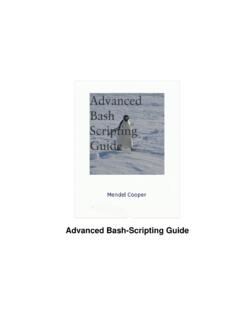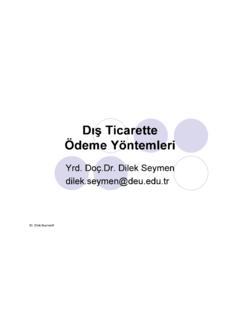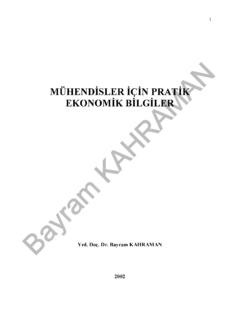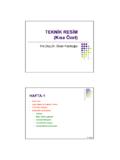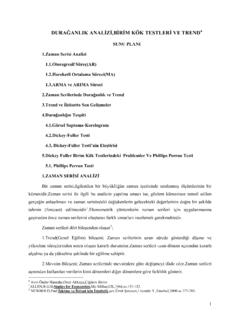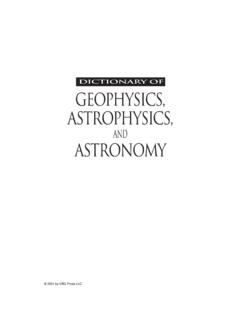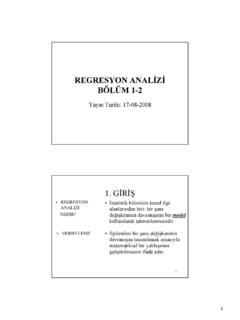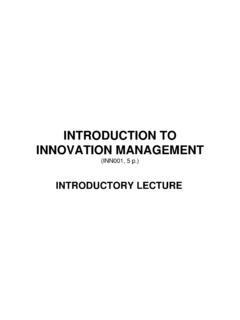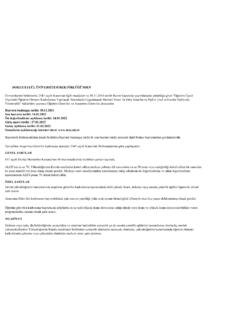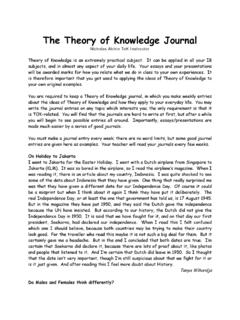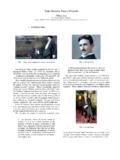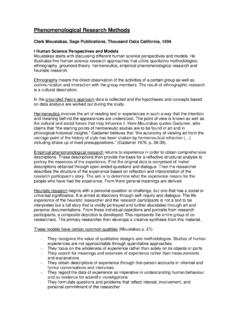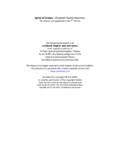Transcription of Theory of Constraints - Dokuz Eylül University
1 Theory of ConstraintsTheory of ConstraintsDr. Seth BatesDr. Seth BatesAdvanced Manufacturing MethodsAdvanced Manufacturing MethodsDepartment of TechnologyDepartment of TechnologyCollege of EngineeringCollege of EngineeringSeth P. BatesSeth P. BatesThe Theory of ConstraintsThe Theory of Constraintspage page 22 Theory of ConstraintsTheory of ConstraintsEliyahuEliyahuGoldrattGoldrat t The Theory of Constraints was developed and The Theory of Constraints was developed and popularized by manufacturing gurupopularized by manufacturing guruEliyahuEliyahuM. M. Goldratt in 1984. Most people are first exposed to Goldratt in 1984. Most people are first exposed to the concepts through his book the concepts through his book The Goal. In 1986In 1986 EliyahuEliyahuGoldratt formed theGoldratt formed theAvrahamAvrahamY. Y. Goldratt Institute. This institute was formed to inform Goldratt Institute. This institute was formed to inform people about TOC (The Theory of Constraints ).
2 People about TOC (The Theory of Constraints ).Seth P. BatesSeth P. BatesThe Theory of ConstraintsThe Theory of Constraintspage page 33 Dictionary Definition of a ConstraintDictionary Definition of a Constraint11the act of the act of constrainingconstraining22the state of being checked, restricted, or compelled to the state of being checked, restricted, or compelled to avoid or perform some action avoid or perform some action <the <the constraintconstraintand monotony of a monastic life and monotony of a monastic life ----Matthew Arnold> Matthew Arnold> 33a a constrainingconstrainingcondition, agency, or force : condition, agency, or force : CHECKCHECK<put legal <put legal Constraints Constraints on the board's activities> on the board's activities> Seth P. BatesSeth P. BatesThe Theory of ConstraintsThe Theory of Constraintspage page 44 TOC sTOC sDefinition of a ConstraintDefinition of a ConstraintThe most common question about the Theory of The most common question about the Theory of Constraints (TOC) is, "Huh?
3 " Constraints (TOC) is, "Huh?"Eli Goldratt defines a Constraint as, 'Anything that limits a Eli Goldratt defines a Constraint as, 'Anything that limits a system from achieving higher performance verses its system from achieving higher performance verses its One definition used by Eli Goldratt for TOC (edited) is:One definition used by Eli Goldratt for TOC (edited) is: A Thinking Process that enables people to invent A Thinking Process that enables people to invent simple solutions to seemingly complex solutions to seemingly complex problems.''Seth P. BatesSeth P. BatesThe Theory of ConstraintsThe Theory of Constraintspage page 55 Here's another definition (from Larry Leach): Here's another definition (from Larry Leach): ~.net/~lleachlleach/ Theory of Constraints states that every system must have at The Theory of Constraints states that every system must have at least one constraint limiting its one constraint limiting its of the Theory :Consequences of the Theory :1.
4 The more complex the system, the less independent process 1. The more complex the system, the less independent process paths exist, so the lower the number of Constraints . (Usually, paths exist, so the lower the number of Constraints . (Usually, complex systems have only one constraint at a given time.)complex systems have only one constraint at a given time.)2. A system of optimum processes can not be an optimum 2. A system of optimum processes can not be an optimum An optimum system runs the constraint (or bottleneck) at 3. An optimum system runs the constraint (or bottleneck) at optimum capacity (focused on the goal of the system), and all optimum capacity (focused on the goal of the system), and all other process steps must have excess process steps must have excess P. BatesSeth P. BatesThe Theory of ConstraintsThe Theory of Constraintspage page 66 TOC sTOC sDefinition of a ConstraintDefinition of a Constraint A process or process step that limits process or process step that limits throughput.
5 Anything that limits a system from achieving Anything that limits a system from achieving higher performance versus its performance versus its goal. A constraint is a factor that limits the system A constraint is a factor that limits the system from getting more of whatever it getting more of whatever it P. BatesSeth P. BatesThe Theory of ConstraintsThe Theory of Constraintspage page 77 What is TOC?What is TOC? The core idea of the Theory of Constraints is that every real syThe core idea of the Theory of Constraints is that every real system stem such as a profitsuch as a profit--making enterprise must have at least one enterprise must have at least one constraint. The TOC is a thinking process that enables people to invent simpThe TOC is a thinking process that enables people to invent simple le solutions to seemingly complex to seemingly complex problems. The Theory of Constraint states that every system must have at The Theory of Constraint states that every system must have at least one constraint limiting one constraint limiting output.
6 There is no choice in the matter; either you manage the constraiThere is no choice in the matter; either you manage the Constraints nts or they mange you. The constraint will determine the output of or they mange you. The constraint will determine the output of the the system whether they are acknowledged and managed, or whether they are acknowledged and managed, or P. BatesSeth P. BatesThe Theory of ConstraintsThe Theory of Constraintspage page 88 How does TOC help companies? How does TOC help companies? Focuses improvement efforts where they Focuses improvement efforts where they will have the greatest immediate impact on will have the greatest immediate impact on the bottom bottom line. Provides a reliable process that insists on Provides a reliable process that insists on follow P. BatesSeth P. BatesThe Theory of ConstraintsThe Theory of Constraintspage page 99 Finding the focal point Finding the focal point Before a company can properly focus, Before a company can properly focus, one necessary condition is that they one necessary condition is that they answer the following question:answer the following question:What is the goal of a forWhat is the goal of a for--profit enterprise?
7 Profit enterprise? Seth P. BatesSeth P. BatesThe Theory of ConstraintsThe Theory of Constraintspage page 1010 The Goal The Goal To make money now and in the make money now and in the P. BatesSeth P. BatesThe Theory of ConstraintsThe Theory of Constraintspage page 1111 The GoalThe Goal(more)(more) Some would say that the goal of a Some would say that the goal of a company is:company is:1)1)To satisfy satisfy )2)To provide satisfying jobs for provide satisfying jobs for P. BatesSeth P. BatesThe Theory of ConstraintsThe Theory of Constraintspage page 1212 The GoalThe Goal(more)(more) TOC Recognizes that only the owner can TOC Recognizes that only the owner can choose the goal, however, once chosen, choose the goal, however, once chosen, the other two goals become conditions to the other two goals become conditions to achieving the the P. BatesSeth P. BatesThe Theory of ConstraintsThe Theory of Constraintspage page 1313 Measuring ProgressMeasuring Progress Once the goal is identified, a necessary Once the goal is identified, a necessary condition to success in achieving the goal condition to success in achieving the goal is to identify which measurement(s) will be is to identify which measurement(s) will be used to judge to judge P.
8 BatesSeth P. BatesThe Theory of ConstraintsThe Theory of Constraintspage page 1414 What measurements should we use? What measurements should we use? (Conventional Wisdom)(Conventional Wisdom) Net Profit?Net Profit? Efficiency?Efficiency? Utilization?Utilization? ROI ROI (Return On Investment)(Return On Investment)?? Cash Flow?Cash Flow?Seth P. BatesSeth P. BatesThe Theory of ConstraintsThe Theory of Constraintspage page 1515 What measurements should we use? What measurements should we use? (TOC Wisdom)(TOC Wisdom)ThroughputThroughputInventoryInve ntoryOperating ExpenseOperating ExpenseSeth P. BatesSeth P. BatesThe Theory of ConstraintsThe Theory of Constraintspage page 1616 What is: ThroughputWhat is: Throughput The rate at which the system generates money through The rate at which the system generates money through sales minus raw materials and and purchased minus raw materials and and purchased parts. All the money received from customers minus raw All the money received from customers minus raw materials cost.
9 The rate at which the system makes money(sales minus The rate at which the system makes money(sales minus totally variable costs). Direct labor should not be totally variable costs). Direct labor should not be deducted in calculating Throughput. Sales are only deducted in calculating Throughput. Sales are only recognized when money is available to the firm. That is, recognized when money is available to the firm. That is, production for inventory is not a part of throughputproduction for inventory is not a part of throughputSeth P. BatesSeth P. BatesThe Theory of ConstraintsThe Theory of Constraintspage page 1717 What is: InventoryWhat is: Inventory All the money the system has invested in All the money the system has invested in purchasing things which it intends to sell. purchasing things which it intends to sell. Some insightsSome insights:: Inventory is a liability, not an asset. Inventory is a liability, not an asset. Raw materials and finished goods are materials and finished goods are inventory.
10 Machines and fixtures (if owned) are and fixtures (if owned) are inventory. Scrap material that is to be sold is inventory until sold. Scrap material that is to be sold is inventory until sold. Seth P. BatesSeth P. BatesThe Theory of ConstraintsThe Theory of Constraintspage page 1818 What is: Operating ExpenseWhat is: Operating Expense All the money the system spends in order to All the money the system spends in order to turn inventory into inventory into throughput. All employee time is operating employee time is operating expense. Depreciation of a machine is a operating of a machine is a operating expense. Scrap material thrown material thrown away. All expenses not deducted in arriving at throughput. All expenses not deducted in arriving at throughput. This includes direct labor and all operating and This includes direct labor and all operating and maintenance expenses. maintenance expenses. Seth P. BatesSeth P. BatesThe Theory of ConstraintsThe Theory of Constraintspage page 1919 The Five Focusing StepsThe Five Focusing Steps Identify a system's constraintsIdentify a system's Constraints Decide to exploit the system s constraintsDecide to exploit the system s Constraints Subordinate everything else to the above decisionSubordinate everything else to the above decision Evaluate / Elevate the system s constraintsEvaluate / Elevate the system s Constraints If in the previous steps a constraint has been broken, go If in the previous steps a constraint has been broken, go back to step 1.
